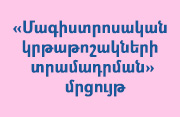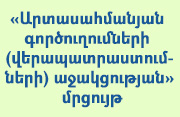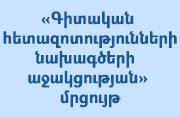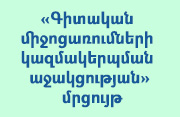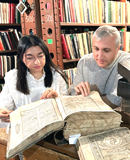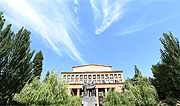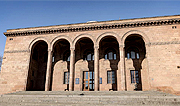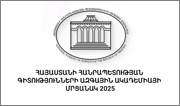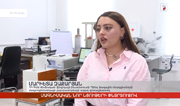|
|
|
|
|
 |
|
Institute of Geological Sciences
Division of Chemistry and Earth Sciences
Specialization: Geology of the Central Segment of the Alpine-Himalayan Belt |
|
|
Main Fields of Activity
The basic scientific research lines are: general and regional geology, seismic tectonics,seismic hazard assessment, geodynamics phanerozoic biostratigraphy, lithogenesis of sedimentary and volcanic-sedimentary formations, geology and petrology of magmatic and metamorphic formations, volcanology, geology of mineral resource deposits, metallogeny, geochemistry and mineralogy of hydrothermal ore formations, geological informatics, engineering geology and hydrogeology, efficient use and protection of geological environment, mapping and assessment of natural landscape geosystems. Geology-oriented research institutes and higher education establishments of Moscow and Leningrad helped greatly in teaching and training of Armenian scientists. In the past years, there were carried out fundamental investigations in various fields of geology and geography, which resulted in several dozens of monographs and numerous scientific publications.
Main Results
Biostratigraphy. The schemes of stratigraphic dissection of the Phanerozoic deposits of Armenia (D-Q), including the scheme of geological staging and zonation classification of the Jurassic, Cretaceous and Palaeogene deposits were developed. The continuous section between the Eocene and Oligocene is accepted as a stratigraphic type within the Mediterranean belt.
Regional Geology, Tectonics, Seismic Tectonics. The schemes of tectonic zonation of Caucasus, Lesser Caucasus and Armenia were developed, various-scale geological and tectonic maps of Armenia and the space-image tectonic map of Caucasus, the Near and Middle East (in the collaboration with the Moscow State University) were compiled. The Institute's researchers participated in drafting of International Tectonic Map of Eurasia and the map of the newest formations of the USSR. In the field of the theoretical geodynamics and tectonics, Academician A. T. Aslanian has developed a hypothesis on free nutational oscillations of the poles, the origin of the Earth's magnetic field, and a quantified model of the substance composition and internal structure of the Earth, and obtained quantitatively justified evidences on the Earth's radius decrease. The seismic hazard assessment (seismic zonation, and long-term earthquake forecast) in the Armenian Highland was made, a geodynamic model of the newest stage was proposed, and the active tectonics map was drafted.
Lithology. Specific features and regularities of various-type sedimentary and volcanic-sedimentary lithogenesis manifestations in the sedimentary-and-tectonic zones were revealed, and the prospects to find bentonites, zeolitolites, diatomites, carbonate formations and silicon earth raw were evaluated. "The Lithological Map of the Armenian SSR" was compiled.
Magmatism and Metamorphism. The schemes of age, formation and geochemical classification of magmatic and metamorphic formations were developed. Petrologic models for major magmatic formations were proposed, and petrologic-and-geochemical criteria of their ore presence were found. The outcrops of the crystalline basement of the Baikalian and Hercinian consolidation age were revealed, their initial compositions of metamorphic facies and the geodynamic conditions of their formation were determined. "The Map of Magmatic and Metamorphic Formations of the Armenian SSR" and "The Map of Crystalline Basement of Armenia" were drafted.
Volcanism. The Palaeovolcanic reconstructions and the Palaeovolcanic maps of Lesser Caucasus for the Jurassic-Cretaceous and Palaeogene-Neogene age sections. About 600 newest volcanous (the Pliocene-Quaternary) were mapped and systematized according to an eruption type, composition and structure in a catalogue. Structural-and-geodynamic conditions of area volcanism manifestations were revealed, and regularities and genetic peculiarities of ignimbritic volcanism were found out "The Maps of Mesozoic and Cenozoic volcanic formations" were drafted.
Ore Formation and Metallogeny. Academician I. G. Magakian contributed greatly into the development of the ore formation theory and the metallogeny. Geological-and-structural conditions for localization, formation and location regularities of the commercial deposits of Armenia were found, regularities in distribution of rare and noble elements in the major ore formations of Armenia were revealed. A new type of gold-ore mineralization localization was distinguished. There were compiled "The World Metallogenic Map", various-scale metallogenic and forecasting-metallogenic maps of Lesser Caucasus and Armenia, large-scale geological and geological-structural, and forecasting-metallogenic maps of the main ore fields and deposits of Armenia.
Isotope Geology. There is developed the scheme of age dissection of Armenia's magmatic, volcanic, metamorphic and ore formations based on the isotope (K-Ar, Rb-Sr) dating. For the first time, there was proved participation of sea water in forming of copper-molybdenum deposits.
Hydrogeology and Engineering Geology. The deposits of mineral waters of Armenia were revealed and classified, and "The Map of Mineral Waters of Armenia" was compiled. Lesser Caucasian province of carbonate boron-bearing rare alkaline-metal waters was distinguished, and the soil-hydrochemical method of prospecting for mineral resource deposits was developed. The engineering-geological technique for classification of mountainous areas was developed, various-scale engineering-geological maps and engineering-geological zonation maps for individual regions and towns of Armenia were drafted.
Geoinformation systems. Development of unified automated system on geological environment of Armenia territory. Data Bases, dynamics, modeling, forecasting, risk and danger estimation, electronic geomapping.
International Activity
The Institute collaborates with various institutes of the Russian Academy of Sciences, University of Montpelier II (France). University of Athens (Greece), ANPA (Italy), IISE (Iran), Georgian Academ of Sciences, grant from the Soros's ISF, NATO Grant, et al.
Other Information
Analitical laboratories of the Institute of Geological Sciencesof the National Academy of Sciences of the Republic of Armenia
A number of analytical laboratories such as chemical, spectral, hydrochemical and isotopic is functioning in the Institute of Geological Sciences of the National Academy of Sciences of the Republic of Armenia. These laboratories provide comprehensive and diversified study of substance compositions of rocks, ores, minerals, fresh and mineral waters:
Determination of chemical composition of rocks (SiO2, TiO2, Al2O3, Fe2O3, FeO, MnO, Mgo, CaO, Na2O, K2O, P2O5, S, H2O-, H2O+);
Determination of contents of Ni, Co, Cr, Au, Ag, Pb, Zn, Cd, Cu, Mo in rocks, ores and minerals (chemical analysis);
Determination of contents of Ni, Co, V, Cr, Ti, Cu, Mo, Ag, Au, Sb, Pb, Zn, Bi, Ga, Y, Li, Rb, Cs, Sr, Ba, As in rocks, ores and minerals (spectral analysis);
Determination of content of Cu, Ni, Co, Cr, Mo, Zn, Pb, As, Ag, Au, P, F, Br, J, nitrites and nistrates in fresh and mineral waters (hydrochemical analysis);
Qualitative and quantitative analysis of hydrocarbons and other volatile organic substances (gas and gas-liquid chromatography);
Qualitative and quantitative analysis of organic compounds in solutions (highly efficient liquid chromatography, HPLC);
Qualitative and quantitative analysis of ions in solutions (ion chromatography);
Spectral and photometric analysis (UV-VIS spectrometry);
Elemental analysis of organic compounds (C, H, N);
Determination of microorganism species in samples (microbioligical analysis of soils);
Determination of isotopic age of rocks (K-Ar and Rb-Sr methods);
Determination of 87Sr/86Sr in rocks and minerals;
Determination of ?18O and ?13C in rocks and minerals;
Gas and gas-liquid chromatography;
Highly performance liquid chromatography (HPLC);
Ion chromatography;
UV-VIS spectrophotometry;
Atomic absorbtion spectrophotometry;
X-ray fluorescent analysis;
Microbioligical soil analysis;
Silicate analysis;
Visual, instrumental, computerized processing of remote sensing information of any character (space image of Landsat TM, SPOT, Soviet systems, air photos). Structural geology studies, structural control of the mine deposits, mine exploration of metals, oil and gas; seismotectonic, volcanological, geotechnical and ecological research using remote sensing methods;
Geodatic surveys by means of GPS technique.
|
|
|
|
|
Notices
Publications in Press
08/12/2025
hetq.am |
05/12/2025
hetq.am |
03/12/2025
aravot.am |
01/12/2025
1lurer.am |
This site has been visited
7 583 314
times since 01.01.2005
|
|
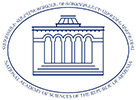


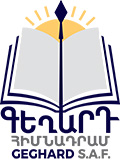
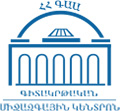









![academy [@] sci.am academy [@] sci.am](images/email.jpg)









